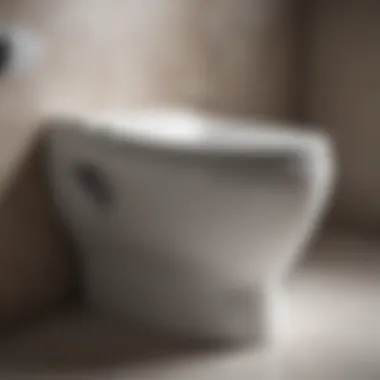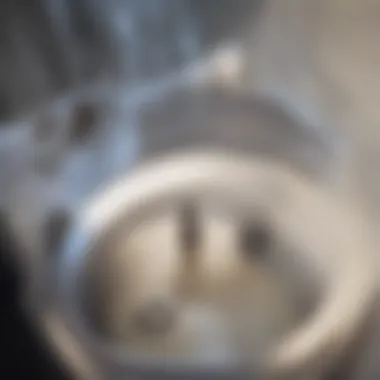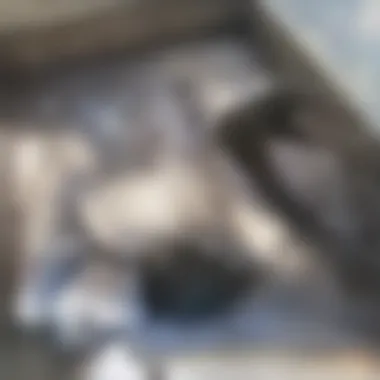A Comprehensive Guide to Removing Water from Toilets


Intro
Removing water from toilets can be necessary for various reasons, ranging from routine maintenance to addressing unexpected issues. Understanding the methods and implications of this process is crucial for any homeowner or caretaker. This guide explores scenarios where water removal is essential, practical techniques for achieving it, and preventive measures to maintain toilet functionality. Through this detailed exploration, readers will gain insights that will enhance their understanding and ability to tackle these tasks effectively.
Feature Spotlight
In the realm of toilet maintenance, it is important to consider the features that can optimize the water removal process.
Practical Tools and Techniques
- Plunger: Often the first line of defense for water removal. A simple yet effective tool that can resolve minor clogs, allowing water to drain.
- Wet/Dry Vacuum: An excellent device for more significant removals, capable of sucking out large amounts of water quickly.
- Bailing Out: Manually removing water using a bucket can be labor-intensive but is effective in emergencies.
"Understanding the tools available for the removal of water can greatly enhance efficiency and prevent damage to the toilet system."
Maintenance Considerations
Maintaining a toilet is not just about water removal. Regular maintenance helps prevent issues before they occur. Some key considerations include:
- Checking the flapper for leaks, which can lead to unnecessary water accumulation.
- Regularly cleaning the tank and bowl to prevent buildup that may affect functionality.
- Monitoring the supply line for any signs of wear or damage.
Complications to Consider
While removing water from toilets may sound straightforward, several complications can arise:
- Clogs: A significant blockage can make the removal process challenging, requiring specialized tools.
- Water Damage: Improper removal can lead to spills, potentially causing damage to flooring and structures around the toilet.
- Sanitation Issues: Any removal process should consider health and sanitation, particularly if it's due to a backup situation.
Preventive Measures
Ensuring that you are proactive about toilet care can reduce the need for urgent water removal. Here are some strategies:
- Invest in a toilet with a built-in water-efficient system to minimize issues of water accumulation.
- Install sensors that alert homeowners if there are problems, such as leaks or excessive water accumulation.
- Regularly inspect all toilet components to ensure they are functioning properly, addressing any issues as they arise.
Understanding the dynamics of water removal from toilets can empower homeowners, allowing them to engage with their home systems more effectively. This knowledge can lead to better functioning toilets and reduced maintenance issues.
Understanding Water in Toilets
Understanding the role of water in toilets is essential for grasping why removal might be necessary. Water serves several critical functions, from waste disposal to maintaining hygiene and facilitating flushing. Recognizing how toilets utilize water provides context for scenarios where removal is required. Whether addressing leaks, winterizing, or handling repairs, knowledge about toilet water storage and functionality underlies effective maintenance and troubleshooting.
The Function of Water in Toilets
Water in toilets primarily functions to create a syphon effect, which is responsible for flushing waste into the plumbing system. When the toilet is flushed, water rapidly fills the bowl, facilitating the necessary pressure to evacuate waste. Additionally, water in the tank ensures that sufficient force is available for repeated use. Moreover, it helps maintain the water seal in the trap, preventing sewer gases from entering the home. In short, this liquid is not merely a vehicle for removal but forms an integral part of a toilet's operational mechanics.
Reasons for Water Removal
There are multiple scenarios that warrant water removal from toilets. One often cited reason is the preparation for repairs or maintenance. In such cases, keeping the toilet dry is vital for performing tasks like replacing seals or unclogging traps effectively.
Aside from repairs, seasonal considerations can prompt water removal, especially in colder climates where freezing could occur. Leaving water in the toilet during winter months can lead to expanded damage, requiring costly repairs.
In summary, understanding both the function and the reasons for water removal in toilets is essential for proper toilet care. It allows homeowners to handle issues efficiently and sustain the long-term functionality of their plumbing systems.
"Water serves not only as a flushing agent but also as a barrier against unwanted gases and odors."
Preparation for Water Removal
Preparing for water removal from toilet systems is a crucial step that can significantly affect the process. Understanding this preparation not only aids in efficiency but also minimizes risks of potential mishaps during the removal process. Every toilet type has its unique considerations. For instance, knowing whether you have a standard gravity toilet or a pressure-assisted one can change the approach for water removal.


Additionally, gathering the right tools is essential. Using inappropriate tools can lead to incomplete water removal and potential damage. Proper preparation ensures that the process is smooth, safe, and effective. It can save time and prevent frustration. Therefore, assessing the toilet type and gathering necessary tools are key preparatory actions that should not be overlooked.
Assessing the Toilet Type
Different types of toilets operate using varied mechanisms. Knowing your toilet type helps in formulating the right method for removing water. Standard gravity toilets rely on a simple mechanism, allowing water to flow from the tank into the bowl through gravity. This type usually requires straightforward techniques for water removal.
On the other hand, pressure-assisted toilets utilize air pressure to assist in flushing. The design is complex; therefore, water removal might require specialized techniques to avoid damaging the internal components.
By recognizing your toilet's specific type, you can choose an appropriate water removal technique, ensuring that the task is executed without complications.
Gathering Necessary Tools
Having the right tools on hand is a fundamental aspect of preparing for water removal. Basic tools often include a wet/dry vacuum, a bucket, and possibly a siphon or hose. Here’s a brief overview of these essential tools:
- Wet/Dry Vacuum: Ideal for sucking out significant amounts of water quickly and efficiently.
- Bucket: Useful for manual bailing out of water, especially when the vacuum is not practical.
- Siphon or Hose: Helpful for creating a siphoning effect to draw water out slowly.
In addition to these tools, consider safety gloves and towels for cleanup after the process. Each tool plays a distinct role, and using the right ones can streamline the water removal process while ensuring safety and hygiene.
Step-by-Step Procedure for Water Removal
The process of removing water from toilets may seem straightforward, yet it involves certain critical steps that ensure effectiveness and prevent complications. Managing water evacuation properly can maintain the integrity of your plumbing system and prevent costly repairs. This section delineates the essential steps necessary for effectively removing water from toilets, addressing the specific actions required for successful execution. Understanding this procedure can alleviate unnecessary stress and promote a sense of control during unexpectedly messy situations.
Shutting Off the Water Supply
Before initiating any water removal techniques, the first action should always be to shut off the toilet's water supply. This step is crucial as it prevents any additional water from entering the toilet during the removal process. Most toilets have a shut-off valve located near the base, typically on the wall behind the toilet. To turn off the water supply, simply rotate the valve clockwise until it is fully closed.
It's worth noting that if your toilet is flooding or if you suspect a major leakage, shutting off the water is vital to prevent further damage. Make sure to flush the toilet before and after shutting the supply to see the current water level clearly.
Using a Wet/Dry Vacuum
Utilizing a wet/dry vacuum is one of the most efficient methods for removing water from your toilet. This device is specifically designed to handle both wet and dry materials, making it ideal for this task. Begin by positioning the vacuum hose inside the toilet bowl. Ensure it is snug so that it can create a seal to prevent spillage. After switching on the vacuum, monitor its performance closely; this should quickly draw the water out.
Be cautious not to aim the vacuum at any electrical sockets or connections, as it operates in wet conditions. A vacuum designed explicitly for water collection can handle significant volumes without risk of damage or an electrical hazard. If you encounter any obstacles, such as debris, it's prudent to address these before the vacuums operation to ensure maximum suction efficiency.
Bailing Out Water Manually
In scenarios where a wet/dry vacuum is unavailable or impractical, manually bailing out water is an alternative method. Although it is less convenient, sometimes this technique may be the only option. Begin by gathering a clean container, like a bucket or small bucket specifically designated for this purpose.
Carefully scoop water out of the toilet bowl, being mindful of any possible mess. Transfer the water to a bathtub or sink when full. This approach requires patience; it may take several trips to manage all the water effectively.
Optionally, employing a ladle can make this process easier. If you foresee a considerable volume of water, consider wearing gloves to maintain hygiene. Regularly assessing your progress will help determine if moving on to a different method is necessary or if manual removal suffices.
"While these methods are effective at removing water, always remember to tackle any underlying issues such as clogs or leaks for a longer-term solution."
In summary, removing water from toilets is a manageable task, provided these methods are employed correctly. Knowing when to act and what approaches to take helps simplify the process, reinforcing the importance of preparation and understanding in these situations.
Dealing with Challenges
Dealing with challenges is a critical aspect of maintaining toilet functionality and performance. When water removal from toilets is necessary, various problems can arise. Addressing these challenges promptly not only ensures proper functioning but also prevents further complications. In this section, we will focus on two main challenges: addressing clogs and identifying leaks. These topics deserve thorough exploration, as they directly reflect the efficiency of waste disposal and the overall hygiene of residential or commercial facilities.
Addressing Clogs
Clogs can significantly hinder the water removal process in toilets. When water drains slowly or backs up, it suggests that debris or foreign objects obstruct the drainage path. It is essential to act swiftly to prevent overflow or damage to the plumbing system. Here are some methodologies to address clogs effectively:
- Plunger Usage: The simplest tool for unclogging a toilet is a plunger. Ensure the plunger has a good seal over the drain hole; several thrusts can often dislodge minor blockages.
- Plumbing Snake: If the plunger fails, a plumbing snake may be more effective. Insert the snake into the drain and rotate it to catch the obstruction, then pull it out.
- Hot Water Solution: For minor clogs caused by waste or toilet paper, pouring hot water into the bowl can help dislodge stubborn material.
- Chemical Cleaners: As a last resort, chemical drain cleaners can dissolve organic matter. However, use these with caution, as they can be damaging to pipes over time.
Important: If the blockage persists after attempting these methods, it may indicate a deeper plumbing issue that requires professional intervention.


Understanding how to effectively address clogs not only aids in the immediate resolution of a problem but also enforces good maintenance practice, preventing similar occurrences in the future.
Identifying Leaks
Leaks present a different set of challenges. They often manifest as water pooling around the base of the toilet or a persistently running tank. Identifying and addressing leaks is crucial for water conservation and maintaining structural integrity within the bathroom. Here are some steps to identify leaks in toilets:
- Visual Inspection: Check for any visible water on the floor near the toilet or around the tank connections. Dark spots on the wall or floor near the toilet can also signal a leak.
- Listening for Sounds: A hissing or constant refill sound in the tank may indicate a leak. This is often due to a faulty flapper or an ill-fitted fill valve.
- Dye Test: Add food coloring to the tank water and wait about 30 minutes without flushing. If the color seeps into the bowl, it indicates a leak in the flapper or valve system.
- Monitor Water Bill: A sudden increase in your water bill can signal minor leaks. It's a wise practice to pay attention to fluctuations that seem out of the ordinary.
Once leaks are identified, addressing them can include replacing worn components like gaskets or seals. In some cases, a complete toilet replacement may be the most robust solution, especially if the unit is older and prone to multiple issues.
Overall, dealing with challenges such as clogs and leaks is vital in maintaining an efficient toilet system. Regular checks and maintenance can mitigate these problems, ensuring both functionality and environmental considerations.
Preventative Measures
Preventative measures play a crucial role in maintaining a functional toilet system. By taking proactive steps, homeowners can avoid the need for reactive water removal. Regularly assessing the condition of toilets can greatly reduce the likelihood of significant issues arising in the future. Small actions, when performed consistently, save time, money, and hassle.
Regular Maintenance Practices
To start, regular maintenance is vital. This includes checking the toilet’s components, like the flapper, fill valve, and flush handle. If any parts show signs of wear, they should be replaced promptly. A worn flapper can cause leaks, leading to excess water usage and increased bills.
Here are some key maintenance practices:
- Inspect for leaks: Look for any signs of water pooling around the base or on the floor.
- Clean the tank: Regularly scrub the interior to prevent mineral buildup. This buildup can affect functionality.
- Test the flush: Ensure the toilet flushes effectively. A weak flush may indicate a clogged drain or need for an adjustment in the tank.
Timely maintenance can prevent more serious issues from developing, which could necessitate larger interventions such as professional help.
Seasonal Considerations
With changing seasons, specific precautions may be needed to prepare the toilet for various conditions. For instance, during winter, plumbing pipes can freeze, leading to larger problems if a toilet is not properly maintained. Insulating pipes or keeping the bathroom heated can help prevent this.
In contrast, spring and summer may necessitate checks for rainwater or flooding, especially in basements. It is wise to monitor your water levels and ensure water is not seeping into areas where a toilet is located.
When considering seasonality, here are points to keep in mind:
- Winter: Insulate pipes and check for proper flushing after extreme temperatures.
- Rainy seasons: Inspect areas for moisture that could lead to mold or damage.
Through a consistent routine of maintenance and awareness of seasonal changes, it is possible to greatly enhance the longevity of toilet systems, ensuring they operate effectively for many years.
When to Call a Professional
Understanding when it is appropriate to call a plumber is crucial, especially when dealing with toilet issues. Recognizing the limits of one's skills can save time and reduce the risk of further damage. Not all toilet problems are suitable for DIY solutions.
Some situations require expertise. Having the right experience can lead to more effective and long-lasting solutions. This section will investigate some of these complex issues and provide clarity on the role of plumbing experts.
Identifying Complex Issues
When it comes to toilets, certain signs point to complications that surpass standard maintenance. Here are some indicators to look out for:
- Persistent Leaks: If there are continual leaks despite attempts to repair them, it may signal deeper plumbing issues.
- Inconsistent Water Levels: Fluctuating water levels often indicate problems with valves or clogs deeper within the plumbing system.
- Strange Noises: Unusual sounds from the toilet can be a sign of a malfunctioning mechanism, which may need professional assessment.
- Frequent Clogs: Regularly experiencing clogs suggests systemic issues, possibly linked to the main pipeline.
Recognizing these issues early can prevent them from escalating.
The Role of Plumbing Experts
Plumbing professionals bring specific skills that are crucial when issues arise. Their expertise can address problems that an untrained individual might overlook.


- Diagnosis: Experts can quickly identify underlying problems. They have tools and techniques to assess the situation thoroughly.
- Repair and Maintenance: Licensed plumbers can provide repairs that guarantee lasting solutions, often implementing preventative measures.
- Compliance with Codes: Plumbing work must meet local building codes. Professionals ensure all repairs comply with regulations, protecting homeowners from future issues.
- Time-Saving: Hiring a professional can save significant time and potential headaches of trial and error.
Considerations for Different Toilet Types
Understanding the variations in toilet systems is crucial when addressing water removal methods. Different toilet types have unique mechanisms, which influence how water removal should be approached. For homeowners and property managers, grasping these distinctions is essential. It ensures that the chosen method is suitable and effective, ultimately preserving the functionality and longevity of the toilet.
Standard Gravity Toilets
Standard gravity toilets operate on a straightforward principle. They use the weight of the water to flush waste. A typical water level is maintained in the tank, which when released, creates a flushing action. When removing water from these toilets, the focus should be on the tank and bowl separately, recognizing that both areas might require attention.
Key Considerations:
- Shut off the water supply before starting.
- Use a wet/dry vacuum or a siphon to remove bowl water easily.
- For stubborn water remaining in the tank, manual removal may be necessary.
Pressure-Assisted Toilets
Pressure-assisted toilets utilize air pressure to enhance the flushing power. This design requires some additional considerations during water removal. Unlike standard models, these toilets may store water under pressure, affecting not only the flushing but also the water removal process.
Key Considerations:
- Always follow the manufacturer’s instructions when attempting to remove water, due to pressurized components.
- Using a vacuum on these toilets requires extra caution to avoid damaging the pressure tank.
- After removal, reinstate air pressure properly to maintain functionality.
Dual Flush Toilets
Dual flush toilets provide two flushing options - one for liquid waste and another for solid waste. This design allows for water conservation but also impacts how water is removed. Each flush type can result in different amounts of residual water in the bowl or tank.
Key Considerations:
- Identify which flush lever correlates to the water level you are addressing.
- Ensure to empty both the solid waste and liquid waste compartments effectively.
- Pay attention to maintain the balance of the dual flushing mechanism post-removal.
In summary, recognizing the specific mechanics of each type of toilet is important when removing water. Understanding these distinctions can prevent damage and ensure the job is done right.
Environmental Considerations
When discussing the process of removing water from toilets, it is essential to consider the environmental impact. Toilets can consume significant amounts of water, and understanding this consumption is crucial. This section addresses how water usage affects our ecosystems and highlights strategies for making more environmentally-conscious choices.
Impact of Water Usage
Water usage in toilets directly contributes to household consumption patterns. On average, a standard toilet uses about 1.6 gallons per flush. If a household is not mindful, this can add up to thousands of gallons annually. The implications extend beyond the household. Increased water demand affects local water supplies and ecosystems. High water usage can lead to over-extraction from rivers and aquifers.
Moreover, waste water produced from toilets can also have ecological consequences. If not treated properly, it can contaminate natural water bodies, harming aquatic life. The importance of managing this resource cannot be overstated. Efficiency can be improved through reduced flush volumes or installing dual-flush systems. This not only conserves water but also reduces the amount of wastewater entering treatment facilities.
Eco-Friendly Solutions
Implementing eco-friendly solutions for toilet water management is paramount in modern practices. Some of these solutions include:
- Low-Flow Toilets: These toilets use less water per flush and are widely available in the market. Many models use approximately 1.28 gallons or less.
- Greywater Recycling: This method involves reusing water from sinks or showers for toilet flushing. By implementing greywater systems, households can significantly decrease the demand for fresh water.
- Rainwater Harvesting: Collecting rainwater for use in toilets is another sustainable practice. It reduces reliance on municipal water systems and utilizes a natural resource.
"By opting for environmentally friendly solutions in toilet water management, individuals can contribute to sustainable resource use and conservation efforts."
Adopting these eco-friendly practices not only benefits the environment but can also lower water bills and promote a more sustainable lifestyle. Choosing efficient systems and methods reinforces the importance of being stewards of natural resources.
End
In this guide, the process of removing water from toilets has been extensively explored. Understanding the importance of this task is crucial. Toilets serve as a central element in household plumbing. They require proper maintenance and occasional repairs to function correctly. Water removal may seem simple, yet it involves various considerations that are vital for efficient toilet operation.
First, addressing the issue of water in toilets goes beyond mere aesthetics. Flushing issues, leaks, or even unpleasant odors can stem from improper water levels. Recognizing the need for water removal helps maintain hygiene and functionality. This insight is particularly valuable for homeowners looking to prevent larger plumbing issues down the road.
Moreover, knowing when to call a professional is an essential takeaway from this article. Sometimes, DIY methods might not suffice. Complex issues such as pipe leaks or major blockages require expert intervention. Understanding the complexity of different toilet types, such as standard gravity and pressure-assisted toilets, can further inform decisions on whether to engage a plumbing expert.
Additionally, a focus on preventative measures cannot be overstated. Activities like regular maintenance practices play a significant role in preventing issues before they arise. Implementing seasonal checks and mindful water usage contributes to long-term functionality and reduces costs associated with repairs.
In summary, this guide provides an in-depth understanding of removing water from toilets. It offers practical steps, addresses potential challenges, and promotes awareness of maintenance needs. By absorbing this knowledge, readers are equipped to navigate the complexities of plumbing with confidence and efficiency.







